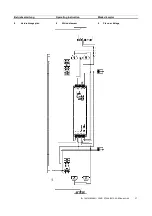
Betriebsanleitung
Operating instruction
Mode d‘emploi
ID: 169701/6008611300/R. STAHL/2013-02-05/de-en-fr-06
18
5.2.1 Notlichtbetriebsdauer
5.2.1 Emergency light duration
5.2.1 Autonomie de secours
Die Betriebsdauer im Notlichtbetrieb ist
abhängig von der Batteriekapazität, sowie
entsprechender Drahtbrücke
The period of operation in emergency light-
ing mode depends on the battery capacity
and an appropriate wire bridge.
L’autonomie en mode secours dépend de
la capacité de l’accumulateur et des
shunts utilisés.
Betriebsdauer
Operating time
Autonomie
Batterie
Battery
Accumulateur
Klemmenbrücke
Terminal jumper
Shunt
Lichtleistung
Luminous power
Rendement
17/18 W
32/36 W
1,5 h
7 Ah
-
100 %
60 %
3 h
mit/with/avec
60 %
30 %
mit Brücke: 3 h
with jumper 3 h
avec jumper 3 h
ohne Brücke 1,5 h (Auslieferungszustand)
without jumper 1,5 h (delivery state)
sans jumper 1,5 h (état à la livraison)
5.2.2 Funktion/Überwachung
5.2.2 Function/Monitoring
5.2.2 Fonctionnement/surveillance
Nach Ausfall der Netzversorgung schaltet
die Elektronik auf Batteriebetrieb.
The electronics switch to battery operation
when the mains supply fails.
En cas de panne de l’alimentation secteur,
l’électronique bascule en mode accumula-
teur.
Ein
wöchentlicher Funktionstest
wird
automatisch durchgeführt.
Hinweis:
Die erste Funktionsprüfung wird
1 Stunde nach Inbetriebnahme durchge-
führt und ist der Beginn der Zeitrechnung
für alle nachfolgenden Funktionstests!
Der
Notlichtbetriebsdauertest
wird 1 x
jährlich durchgeführt. Dabei wird die Batte-
rie auf Entladeschlussspannung entladen.
Dadurch entfällt ein jährliches Entladen zur
Wartung der Batterie. Der Test gilt als
bestanden, wenn beim Entladen der Batte-
rie die eingestellte Notlichtbetriebsdauer
überschritten wird. Befindet sich die
Leuchte durch einen Netzausfall länger als
die eingestellte Notlichtbetriebsdauer im
Notlichtbetrieb, so wird dies als Notlicht-
brenndauertest gewertet. Das Zeitintervall
wird danach wieder auf ein Jahr gesetzt.
A
weekly function test
is carried out au-
tomatically.
Note
: The first functional test is carried out
1 hour after putting into operation and is
the start for calculating the times of all
subsequent function tests.
The
emergency light continuous opera-
tion test
is carried out once per year. In the
process, the battery will discharge on cell-
end voltage. A yearly discharging for the
maintenance of the battery is not re-
quired.The test is passed, if the timed
emergency light operation is exceed by
discharging of battery. Is the light fitting by
a power failure longer than the timed emer-
gency light continous operation in emer-
gency operation so will this noticed as an
emergency light continous operation test.
After that, the time interval is set for a year.
Un
test de fonctionnemen
t
hebdoma-
daire
est exécuté automatiquement.
Remarque
: Le premier test fonctionne-
ment est effectué 1 heure après de la mise
en service et est le début pour calculer les
temps de toute autre test de fonctionne-
ment.
Le test
automatique du BAES
est effec-
tué une fois par an. Pendant ce test la
batterie est ramener jusqu’au minimum de
décharge. Ce test exclus une autre vérifi-
cation de la batterie. Le test est positif, si
la durée nominale de fonctionnement du
BAES est dépassée. Si le BAES se trouve
en conditions de secours suite à une cou-
pure électrique, ceci est validé comme
test. Le compteur de test se trouve réinitia-
liser pour un an.
Der erste Betriebsdauertest wird zufällig
bestimmt und liegt in einem Zeitfenster
von 1 Tag bis 44 Tagen.
The first continuous test is determined by
chance and lies in a period of 1 day to 44
days.
Le premier test est déterminé par hasard
et il est dans une fenêtre de temps de 1
jour jusqu'à 44 de jours.
Der automatische Notlicht-Brenndauer-
Test ist nur bei Plusgraden (> 0°C) sinn-
voll, da bei Minusgraden (< -5°C) aus
physikalischen Gründen kaum noch eine
Ladung stattfindet.
The automatic emergency light continuous
“on“ test is only useful with ambient tem-
peratures in the positive range (> 0°C),
because at negative temperatures (< -5°C)
virtually on charging tales place for physical
reasons.
Le test d’autonomie de l’éclairage de se-
cours n’est judicieux que pour les tempé-
ratures ambiantes positives (> 0°C), étant
donné que pour les températures néga-
tives (< -5°C) la charge de la batterie est
quasi inexistante pour des raisons phy-
siques.
Durch das damit eingeschränkte Kapazi-
tätsvermögen des Notlichtakkus würde der
Notlicht-Brenndauertest zu fehlerhaften
Ergebnissen führen.
The thereby reduced emergency light bat-
tery capacity would the emergency light
continuous test lead to incorrect results.
La capacité ainsi réduite de la batterie de
secours pourrait le test d’autonomie en
fonctionnement de secours mener à des
résultats incorrects.



























